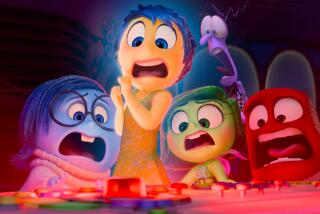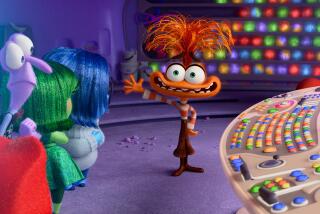Disney dishes up a gamble
In the new computer-animated comedy “Ratatouille,” Remy the rat dreams of becoming a great chef.
But Remy has a problem: He’s an unwelcome intruder in the kitchen of a gourmet Parisian restaurant where he yearns to work.
Likewise, Walt Disney Co. and its Pixar Animation Studios knew early on that they could end up chasing their tails if they didn’t figure out how to sell “Ratatouille’s” unsavory plot to kids and their parents who have plenty of choices. Not only are rodents in restaurants an unappetizing notion, but the movie arrives today with a buffet of other family films waiting to be served up.
“This is the toughest movie we’ve ever had to market,” concedes Ed Catmull, president of Pixar and Disney Animation Studios. “It’s difficult to convey such an odd premise -- rats and cooking....We’re in unknown territory.”
That’s just one of the marketing challenges Disney and Pixar have faced trying to lure audiences. Merchandise sales are another: Stores are overflowing with items from “Spider-Man 3,” “Shrek the Third,” the upcoming “Transformers” and other movies, making it tougher to persuade parents to spend an additional $7.99 to $19.99 on a plush rat.
In Hollywood and on Wall Street, “Ratatouille” is being closely watched as the first film released since Disney acquired its longtime partner last year for $7.4 billion. So far, Pixar is a perfect seven-for-seven at producing hits.
Disney and Pixar used to share the movie costs. Now, Disney foots the entire bill, which, in the case of “Ratatouille,” comes to more than $200 million in production and worldwide marketing expenditures.
Most industry watchers are convinced that the quirky subject is a gamble at the box office. Some analysts believe “Ratatouille” may not perform up to the blockbuster level of such past Pixar gems as “Finding Nemo,” “The Incredibles,” “Cars” and “Toy Story 2,” all of which grossed more than $450 million worldwide.
The good news for Disney is that reviews have been overwhelmingly positive. Time magazine’s Richard Corliss called the film “solid, seductive story-telling. Look for Pixar to extend its unbeaten streak to eight.”
Even if “Ratatouille” falls short, analysts believe Disney’s decision to acquire the industry’s top computer animator was a winner.
“It’s an important movie,” said media analyst Jessica Reif Cohen at Merrill Lynch & Co. “But even if it underperforms the other Pixar films, the acquisition won’t be judged by this movie alone.”
One reason: Catmull and Pixar creative guru John Lasseter have already invigorated Disney’s beleaguered animation operation since taking over a little more than a year ago.
Also, noted Reif Cohen, Disney has now reclaimed “the best brand in the animation business” after holding the title itself for decades. To many parents, the name “Pixar” has become synonymous with clean fun, laughs and dazzling, state-of-the art 3-D animation.
“Even the kids know the brand,” said Paul Dergarabedian, owner of box office tracking firm Media by Numbers.
Media analyst Richard Greenfield of Pali Research concurs with Reif Cohen that the acquisition of Pixar “was so important to Disney from a franchise standpoint.” Greenfield also said that although there’s a general concern that “Ratatouille” may not live up to past Pixar hits, he believes the picture will ultimately be profitable worldwide.
Still, Catmull is concerned about all the attention being given to Paramount Pictures’ “Transformers,” which debuts Monday night. The expected Warner Bros. blockbuster “Harry Potter and the Order of the Phoenix” arrives the following week.
“There’s a lot of competition, and we could get lost in the noise,” Catmull said.
To succeed, Catmull believes the studio must distinguish “Ratatouille” from the deluge of other “fast-talking” animal movies.
The last 18 months has been cluttered with animated films featuring enough talking animals to fill a zoo. Among them: penguins (“Surf’s Up,” “Happy Feet”); turtles (“TMNT”); a grizzly bear and mule deer (“Open Season”); a raccoon and other forest creatures (“Over The Hedge); a saber-tooth tiger, sloth and wooly mammoth (“Ice Age: The Meltdown”); a wolf (“Hoodwinked”); and another talking rat (“Flushed Away”).
“Our humor is character based, not joke based,” Catmull explained. “And it’s hard to convey character-based humor in the ads.”
Another obstacle has been figuring out to teach people to pronounce “Ratatouille,” a French vegetable stew. The studio decided to take the advice of the film’s director, Brad Bird, who also made Pixar’s “The Incredibles,” to turn the name into a joke by spelling it out phonetically (“rat-a-too-ee”) below the title in its advertising campaign.
Knowing it has a likely hit fans might rave about, Disney took the unusual step of holding the first-ever sneak preview of a Pixar film this month in more than 800 theaters.
“The reason for the sneak is that people go out and tell their friends,” Catmull said.
Then there was the retailer problem. The subject matter wasn’t an easy sell to stores, prompting the studio to launch a much smaller merchandise program than it had for such movies as “Cars” and the “Toy Story” films that were naturals for children’s products.
“We were able to sell a program, but at nowhere near the same success as a film based on a natural play pattern,” said Gary Foster, spokesman for Disney’s consumer products division.
Foster said “Cars” was by far the best seller of merchandise for any Pixar or Disney animated movie. The film generated retail sales of more than $2 billion in its first year and is forecast to generate at least another $2 billion for Disney’s 2007 fiscal year, ending in September.
As for “Ratatouille’s” merchandising prospects, Foster said, “It’s definitely going to be on the lower-end,” probably closer to Pixar’s 1998 release, “A Bug’s Life,” which also was a difficult pitch.
Along with the usual line of plush toys, action figures, books, video games, stationery, party ware and bedding, the Burbank studio is selling kitchen utensils (including a “Ratatouille” timer and bottle stoppers) at the Disney Stores, now owned by Children’s Place Retail Stores Inc. There’s also children’s cookware and tableware exclusively at upscale kitchenware retailer Sur La Table; and cheese platters and “Ratatouille”-branded French chardonnay wine ($12.99 a bottle) that goes on sale exclusively at Costco Wholesale Corp. in August.
Moviegoers may wonder why Disney decided to sell white wine when it is only fine red wine that flows through the movie.
“We could not find a good source [winery] for red wine so we went with the white,” Foster said.
It also marks the first time that Disney is promoting an alcoholic beverage tied to a film, part of a larger effort to extend the family entertainment giant’s name into adult products such as couture fashions and furniture lines.
“Everyone knows that wine is for adults and that Pixar movies have a very wide reach that includes adults,” Foster said.
How wide that reach is still depends on whether Disney and Pixar can cook up enough ways to get moviegoers to order “Ratatouille” when they get to the box office. No matter how hard it is to pronounce.
--
(BEGIN TEXT OF INFOBOX)
Rats! Another animal talkie
At least 10 movies have been released since January of last year featuring fast-talking animals. Here’s how those movies did at the box office and Pixar’s previous movies.
*--* Title Release date Distributor ‘Global gross* Surf’s Up’ 6/8/07 Sony $56,100,000** ‘Shrek the Third’ 5/18/07 Paramount 480,700,000** ‘Teenage Mutant Ninja Turtles’ 3/23/07 Warner Bros. 92,200,000 ‘Happy Feet’ 11/17/06 Warner Bros. 384,200,000 ‘Flushed Away’ 11/3/06 Paramount 176,300,000 ‘Open Season’ 9/29/06 Sony 189,000,000 ‘Over the Hedge’ 5/19/06 Paramount 335,200,000 ‘The Wild’ 4/14/06 Buena Vista 102,300,000 ‘Ice Age: The Meltdown’ 3/31/06 Fox 651,500,000 ‘Hoodwinked’ 1/13/06 Weinstein Co. 109,500,000
*--*
*Through 6/24/07
**Still playing
--
Global box office of previous Pixar movies
(in millions)
‘Finding Nemo’ (‘03): $867
‘The Incredibles’ (‘04): $636
‘Monsters, Inc.’ (‘01): $529
‘Toy Story 2’ (‘99): $486
‘Cars’ (‘06): $462
‘Toy Story’ (‘95): $362
‘A Bug’s Life’ (‘98): $358
--
Source: Media by Numbers
More to Read
The biggest entertainment stories
Get our big stories about Hollywood, film, television, music, arts, culture and more right in your inbox as soon as they publish.
You may occasionally receive promotional content from the Los Angeles Times.










